
Rediscovering Japan

Rediscovering Japan
Travel (Aizu Part 2 (Aizu-Wakamatsu))

by tomizuta
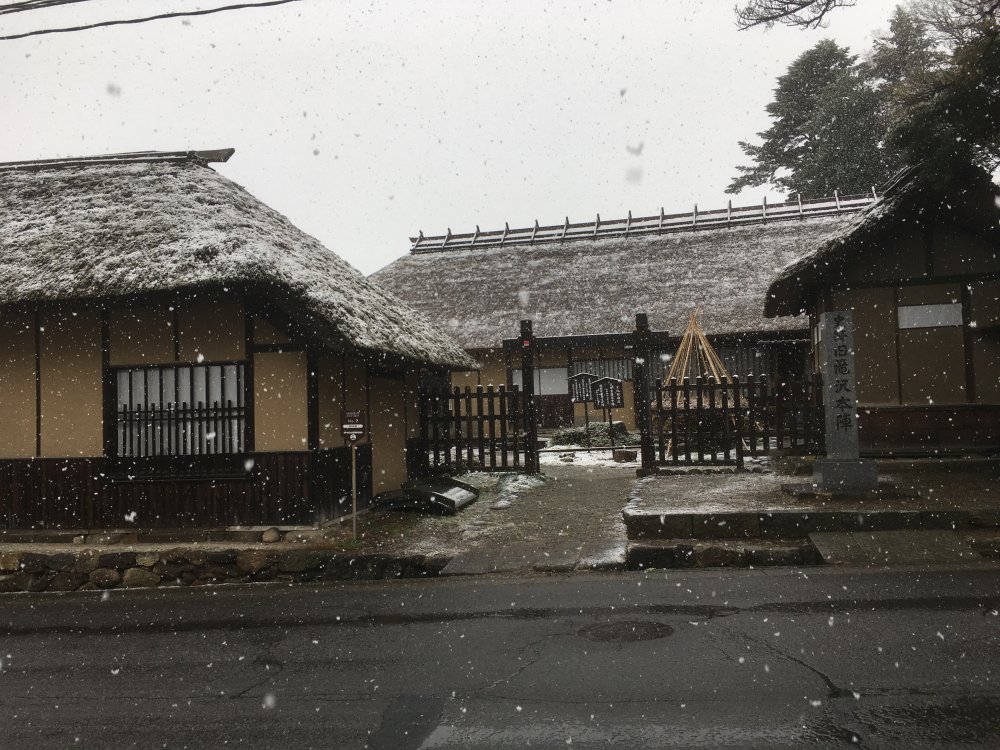
It had started to snow when we visited Takizawa honjin.
We left Higashiyama Onsen early morning to explore the city of Aizu-wakamatsu. Unfortunately it was snowing. We were happy to learn that many of the places we intended to visit opened as early as from eight am. Our first visit was to Takizawa honjin. In the Edo era feudal lords had the privilege as well as obligation of periodically visiting the shogun in Edo Castle. The frequency of the visit varied, some every six months to some in the farthest areas every couple of years. For the Aizu lord it would be to visit and spend one year in Edo every two years. Honjin in the Edo era was a designated resting or lodging place for the feudal lord typically used in his back and forth travels to and from Edo. Usually a private house of the chieftain of the village would dedicate a special space for this purpose. No other guest was allowed use of the dedicated space. Takizawa honjin was the honjin closest to Aizu-wakamatsu Castle.
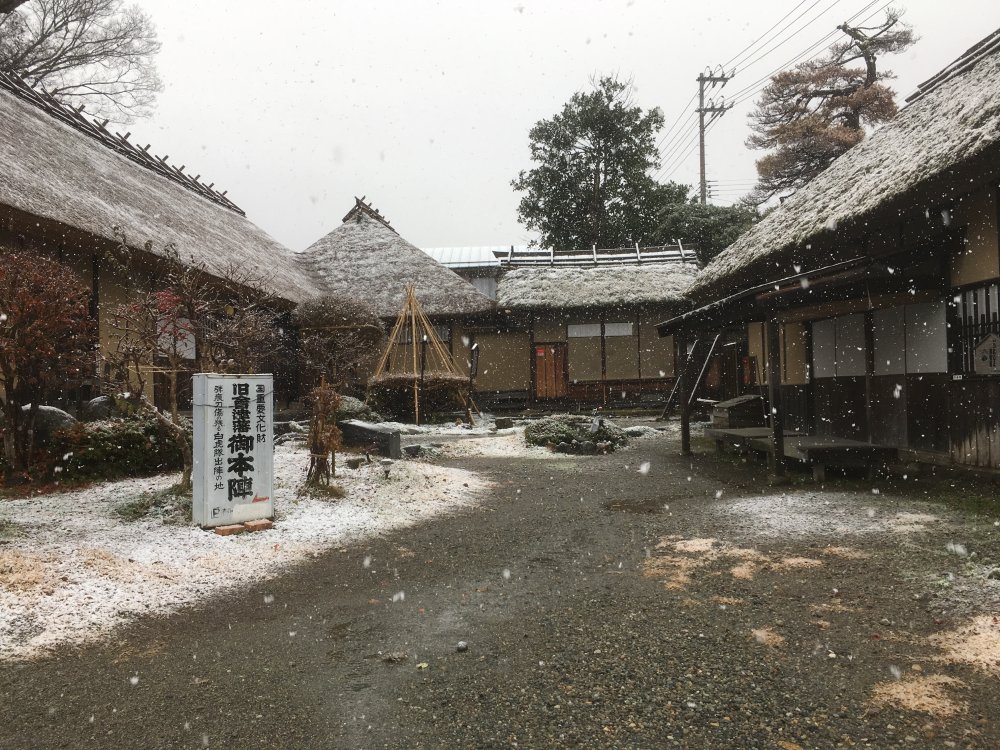
View of the honjin from the car park. The sign says Important Cultural Heritage, former honjin of Aizu fiefdom.
Although it was past the opening hour the premises seemed closed. We rang the calling bell at the admission office which was part of an adjacent private house. Shortly an elderly lady came to the door. “Oh I’m so sorry. I didn’t think we would have any visitors in this snow“. She then opened up the honjin building, invited us in and showed us around. She told us quite a lot. We learned that there was a special entrance gate for the feudal lord from where he would proceed to the designated guest room. We were shown the bullet holes and sword cuts to the pillars when the honjin was attacked by the anti-shogunate army.
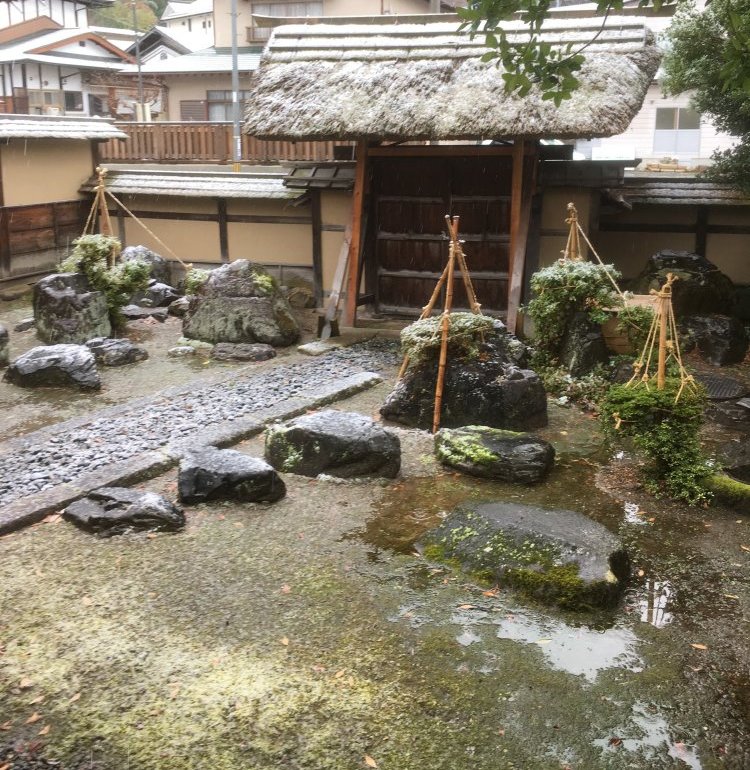
The special entrance gate solely for the feudal lord.
We also learned that this was the oldest surviving honjin in the Touhoku district. The Takizawa honjin was the residence house of the Yokoyama family. We were surprised when the lady guiding us told us that she was the seventeenth generation descendant of the Yokoyama family. “Not many designated cultural heritage buildings like this continue to be privately owned because of the cost of maintaining the place even with governmental subsidies. The private owners meet periodically to discuss petitions to the government. One such meeting was held here as we rotate venues”. She opened another room to show us the Japanese garden. Although compact it was in the neat style of Enshuu Kobori, the master landscapist. We asked the way to our next visit, Sazaedou. “Leave your car in the car park. It’s only a ten minutes’ walk from here. I might as well keep the honjin open. We might have some guests. Next year is a hundred fifty years from the Meiji Restoration and events are being planned. We recently had a professor from Tokyo University visiting us”. We were really impressed with the honjin as well as the bits of information we received.
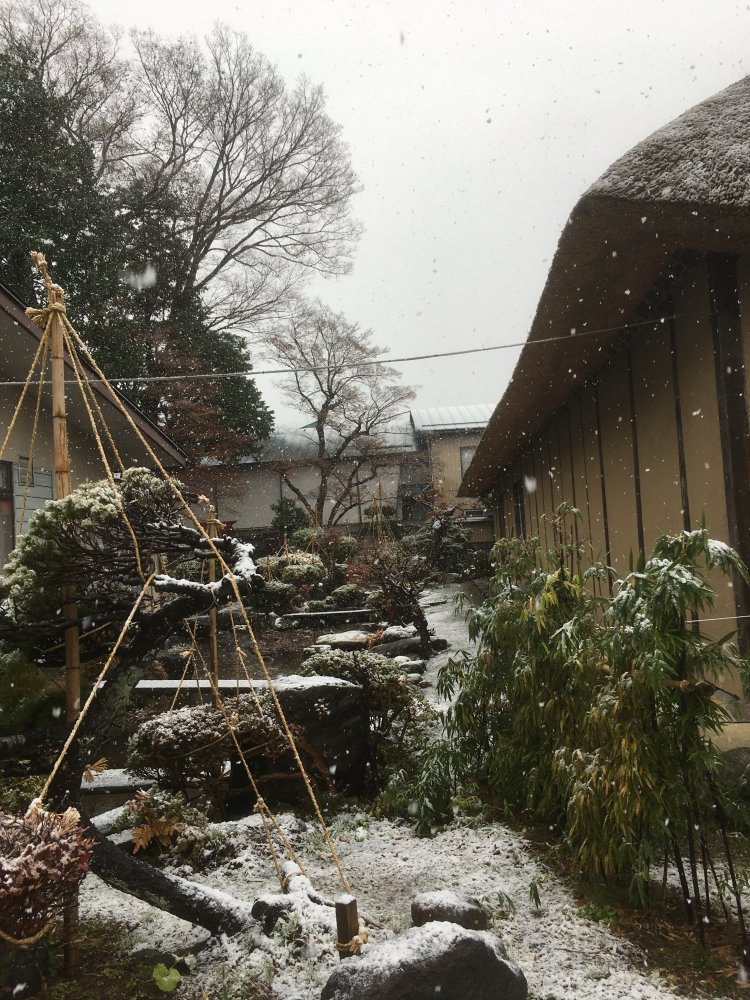
The Japanese garden was compact but in the Enshuu Kobori style. I was told that there is no subsidy for its maintenance.
Bosatsu in Buddhism is a monk practicing and preparing to enter into a status of total awareness like Buddha. Because it is so difficult to achieve the same status as Buddha, it is believed that a bosatsu will spread the teaching of Buddha, sympathize with ordinary folk and help guide them to enter heaven. Kannon bosatsu is a particularly benevolent bosatsu that takes thirty three different appearances depending on the person it is helping. Some Kannnonbosatsus have many hands and an eye on each palm. These are called Senju (meaning one thousand hands) Kannon bosatsu. The hands and eyes allow Kannon bosatsu to find out and aid the many in need of help. A pilgrimage route to visit thirty three Kannon bosatsus in the Kinki area starting from Seigantoji Temple in the Kii pilgrimage route (a World Heritage site) was developed by the twelfth century. Pilgrimage routes to visit thirty three local Kannon bosatsus for those that could not afford to go to Kii were also designated in the Edo era. Sazaedou is an even more compact attempt to pay respect to thirty three Kannon bosatsus. By travelling up and coming down by another slope in the tower one could pay respect to thirty three Kannons displayed there. This was an invention of a Buddhist priest of a now discontinued Buddhist temple in the late eighteenth century. Sadly due to the movement to destroy Buddhist statues in the Meiji days in which Shintou became the national religion of Japan, the Kannons in the Sazaedou were all displaced and the places they were displayed all remain vacant. Sazae is a spiral shellfish and the shrine is so named because of its spiral shape.
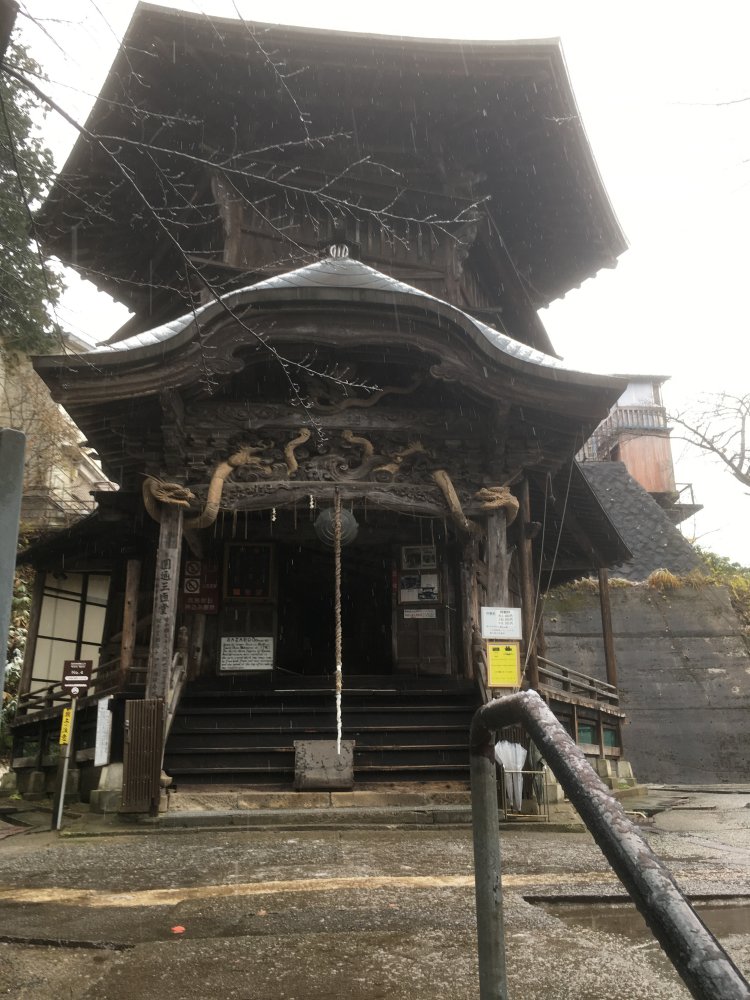
Sazaedou as it appears in front of you as you come up the stairs. You enter from this entrance and come out from the back.
We picked up our car at Takizawa honjin to leave for the gardens of Oyakuen.Oyakuen literally means “medicinal herb garden”. I understand that the garden was part of a villa of the Ashina family that ruled Aizu until the late sixteenth century. Upon the fall of the Ashina family, rule of Aizu moved to the Gamou family the first ruler of which was a Christian lord, followed by the Uesugi family, then returned to the Gamou family, to the Kato family until finally to the Matsudaira family which rule lasted to the Meiji Restoration. The reason for the frequent changes of rule was due to Aizu’s strategic military importance and the Tokugawa shougun finally decided to entrust it to a descendant of the Tokugawas in 1643. The name Matsudaira was only allowed to such descendants.There is a herb garden on the left of the site after you enter from the gate which was started by the second and third Matsudaira lord which became the namesake of the garden of Oyakuen.

A signboard in front of the garden tells you the history of Oyakuen.
I’d like to take a moment to talk about Japanese gardens. Chinese gardening
techniques and styles were brought to Japan around the 6th and 7th century.
The Japanese are very good at importing ideas from abroad and then gradually
converting it to a polished Japanese style based on Japanese culture. Gardens
are no exception. Around the 11th century, paradise gardens were developed.
These are gardens representing the paradise existing in the west where
the followers of Buddha resided. One good example is the gardens of Byoudouin
in Uji, Kyoto. Following the import of Zen belief around the 12th century,
Zen monks developed a new style garden based on stoic Zen belief. A typical
style is the rock garden. Ponds and water are depicted by sand, a very
simple style ideal for Zen meditation. One good example is the gardens
in Ryouanji in Kyoto city. Japanese gardens further developed in the late
16th to 17th century. The feudal lords built their grand promenade gardens
where they could enjoy a walk along a pond to enjoy various picturesque
surroundings.

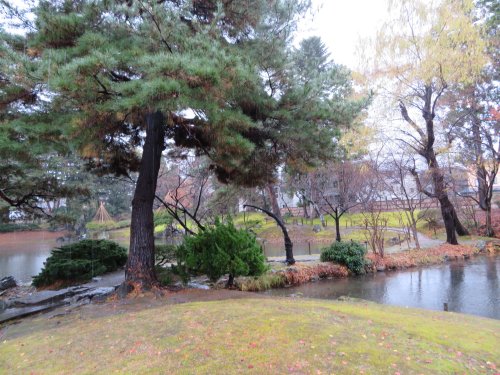
You can see how the scenery changes as you walk around the pond. Close to the entrance (left) and on the opposite side (right)..
An early landscapist was Enshuu Kobori. I introduced one of his masterpieces in my article on Okayama. The vast Japanese garden on the right of the herb garden is the work of a follower of Enshuu. It has typical straits of a promenade garden with the promenade course that goes around the lake through various settings with a tea ceremony room on an island.
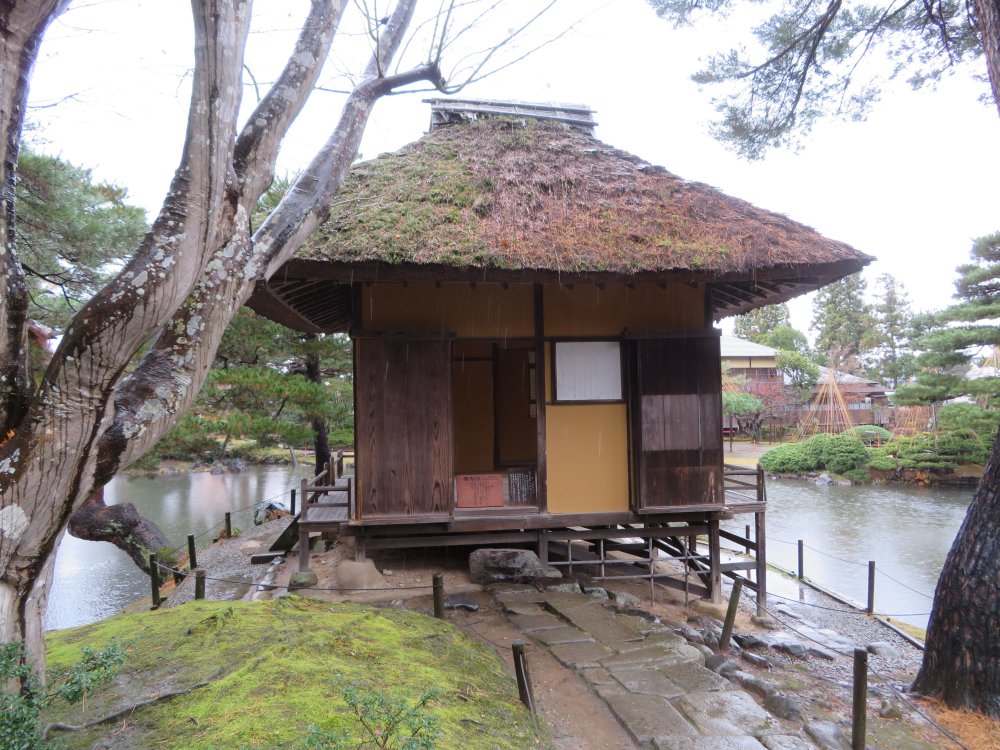
View of the tea ceremony room jutting out to the middle of the pond.
We then went to the Samurai residence open air museum. The main feature is the replica of the residence of a top ranking samurai of the Aizu fiefdom, Tanomo Saigou. It is spacious with thirty eight rooms. By walking around the building you get a good feel of how grand samurai residences of this rank were.
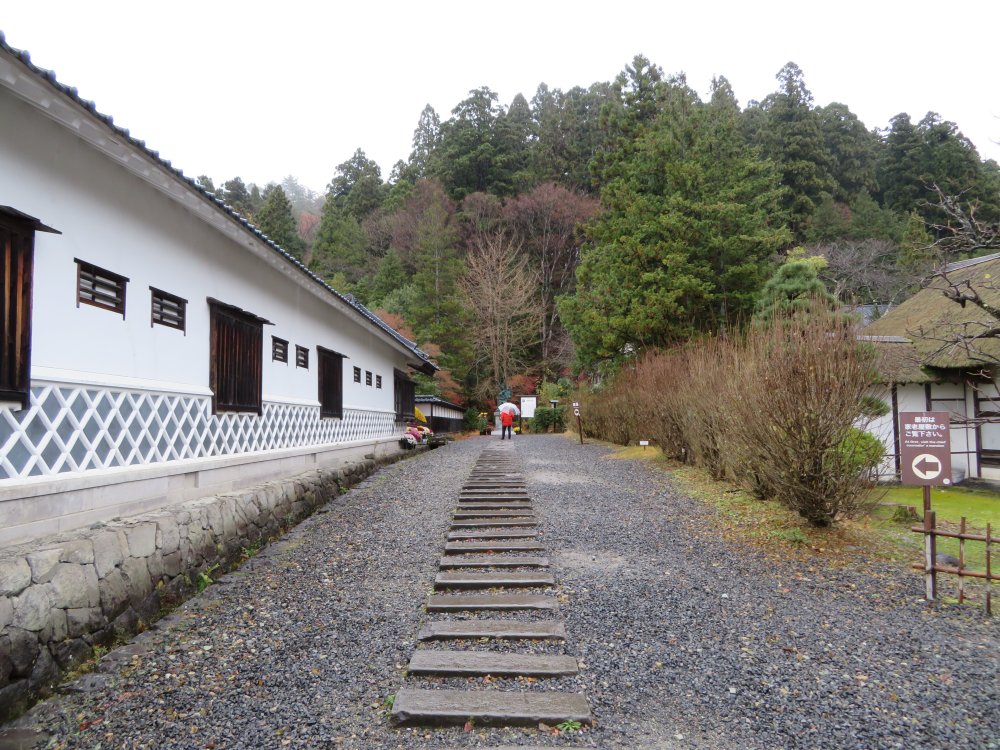
The grand wall of Tanomo Saigou's residence on the left.
Also worth seeing is the former Nakahata jinya. This belonged to a subordinate of the Tokugawa shougun. Such subordinates were given land from where they could collect taxes in the form of rice. The subordinates would rarely travel to their assigned land and would assign someone to govern on his behalf. In case of the Nakahata jinya, the assigned land covered seven villages to govern, and the jinya was the residence of the governor as well as office including a court. Although they have museums and gift shops and other attractions, I thought it wasn’t enough to meet the admission fee of eight hundred and fifty yen.

Nakahata jinya belonged to a direct subordinate of the Tokugawa shougun as his residence and office to govern his land.
We next went to explore the township of the joukamachi (castle town) of Aizu-wakamatsu. It’s always interesting to visit the samurai residence district and the merchant district. The main street of the merchant district is Nanukamachi Street. Here some of the Edo era heritage has been preserved. So I suggest you stroll the streets to pick up some gifts at the shops.
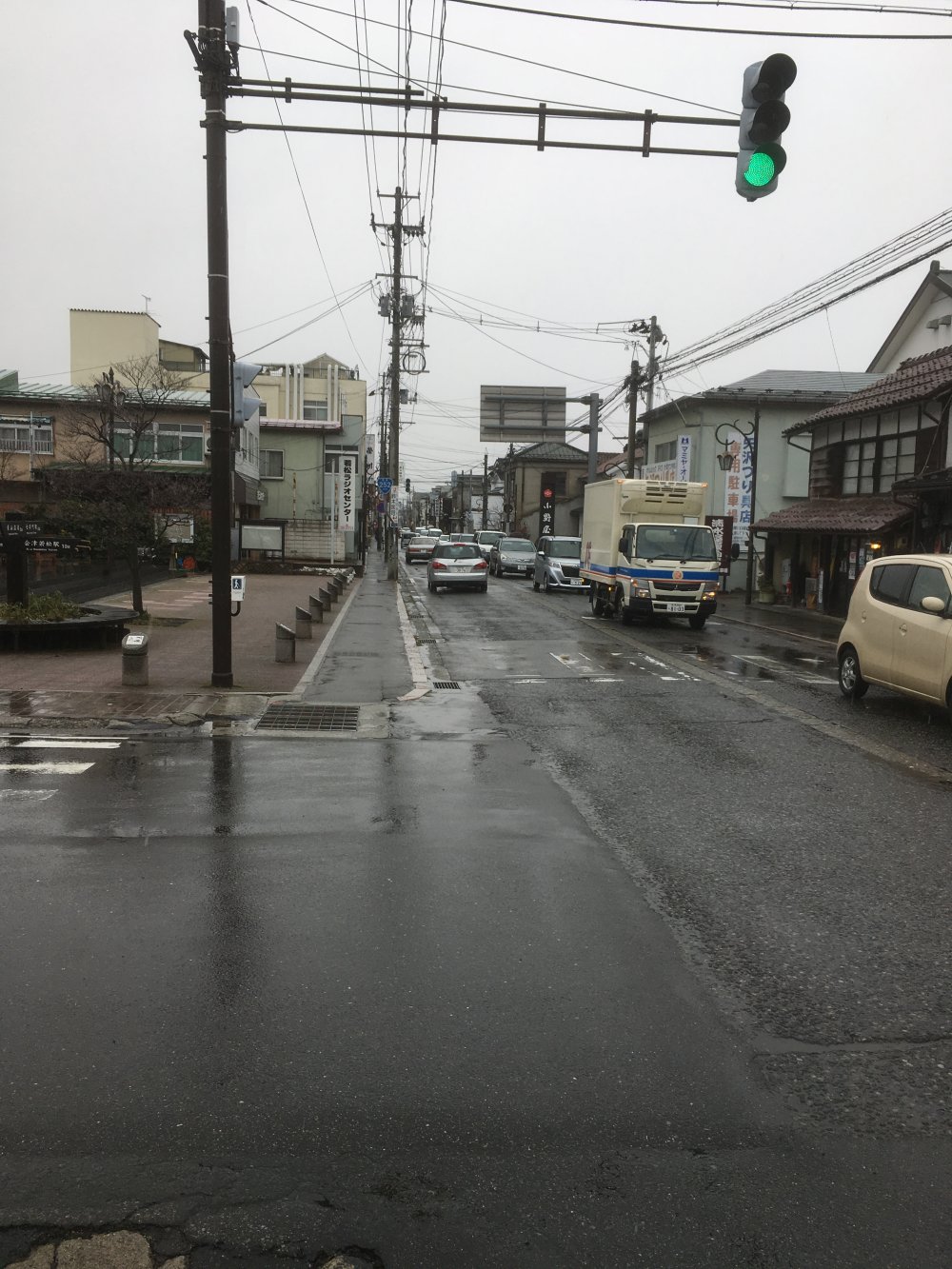
View of Nanukamachi Street looking west from east.
One interesting feature of Nanukamachi Street is the odd zigs and zags the route takes. Usually this is a defense mechanism seen in castle towns so that invaders will have to take a zig zag route stalling their progress and making it easier for a counter attack. Our voluntary guide at Tsuruga Castle that I’ll introduce later told us that it was to block flooding as the land is slanted from the higher east to the lower west. Upon further study, it appears that she was right that it was not as a defense mechanism but related to water. The majority view appears to be to change the flow of water from east to west to occasionally north to south so that water could be supplied to a larger area. It also appears this was the invention of the Christian lord UjimasaGamou according to the City of Aizu-wakamatsu.
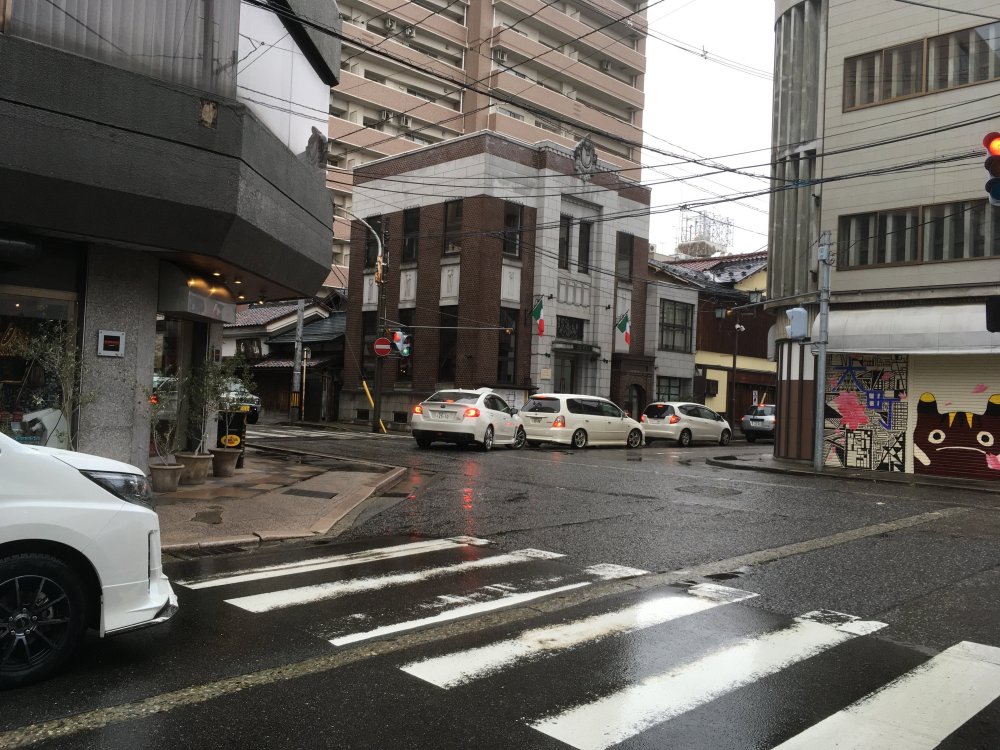
One interesting feature of Nanukamachi Street is the odd zigs and zags the route takes.
My next task was to visit a local sake brewery. I had selected Miyaizumi Brewery as they were close to our following place of interest Tsuruga Castle and as I was interested to take a brewery tour. Unfortunately we were told that they had discontinued brewery tours. “After the Tohoku earthquake in 2011, we had to rearrange the production line so that the route of visitors was too close to the production line raising concern from the local hygiene office. We discontinued tours last autumn”. They do have a large tasting area. I was happy to notice the staff was regularly checking that none of the various sakes offered for tasting were empty. To my question as to how many sake breweries are in the area I was told that the number has dwindled to a dozen which is probably less than a third compared with a hundred years ago. Miyaizumi sells only locally with the exception of one brand Sharaku which is sold in Tokyo. Coincidentally a couple of days after my return I noticed a restaurant serving Sharaku which I immediately ordered. I bought a 1.8 liter bottle of special honjouzou Miyaizumi. Because the rice has been polished to an unusually high sixty per cent for a honjouzou I found it richer with a pleasant bouquet.
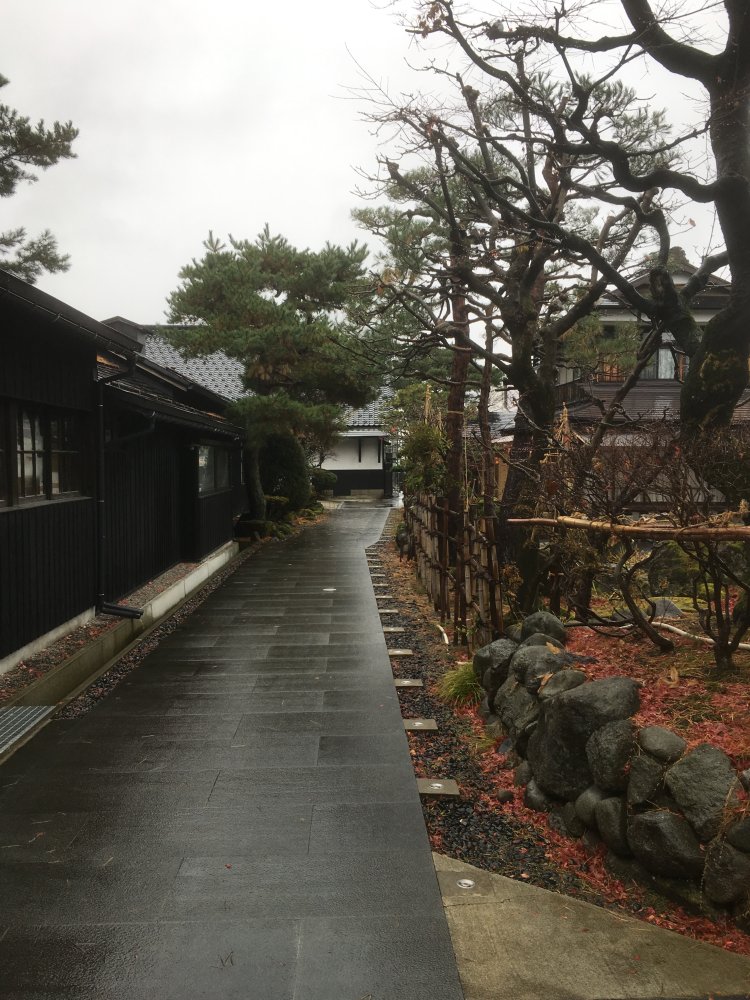
Inside Miyaizumi Meijou Brewery. Brewing area on the left.
It was past two by the time we got to Tsuruga Castle. The distance from the car park to the castle area wasn’t that long. It appears a castle stood at this site from the fourteenth century, but it was only in the late sixteenth century that it was modernly expanded by Ujisato Gamou. The castle was severely damaged after the Aizu War in 1868 and was subsequently demolished. What remains today is the bare ground of the former site of the main castle building and the keep reconstructed in 1965 using reinforced concrete. We noticed a signpost showing next guided tour from two thirty. I went to the information office to tell them we wished to join the tour. “Oh you don’t have to wait. Let me call the voluntary guide now.” Momentarily a lady volunteer guide appeared and suggested we start immediately. When we asked if we shouldn’t wait till two thirty, she told us not to worry and changed the signpost to show next guided tour two fifty. “I’ve already informed the other guide” she said. She showed us some interesting places in the castle grounds. One was the approach to the main castle site. Although this has now been paved, she took us aside to show the original approach. “Notice that the space between each step is not the same. The reason is to stall the approaching enemy by causing them to trip against each other”. She took us to the bottom of the keep and drew our attention to the stone mound. “This is in contrast to the stone walls which use much larger and heavier rocks”. The stones used in the stone mound were much smaller and appeared to be put on top of each other randomly. “There were some cracks and other damage to the stone wall caused by the earthquake but none at the castle mound.” She next pointed up to the bottom of the keep. “Notice that the keep is contained within the mound, when usually keeps are constructed to stick out of the mound so that the enemy climbing up the mound could be attacked from the keep above. That’s because originally a seven story keep was built until replaced by a five story keep as it was considered to be offensive to the Tokugawa shougun who resided in Edo Castle with a five story keep”.
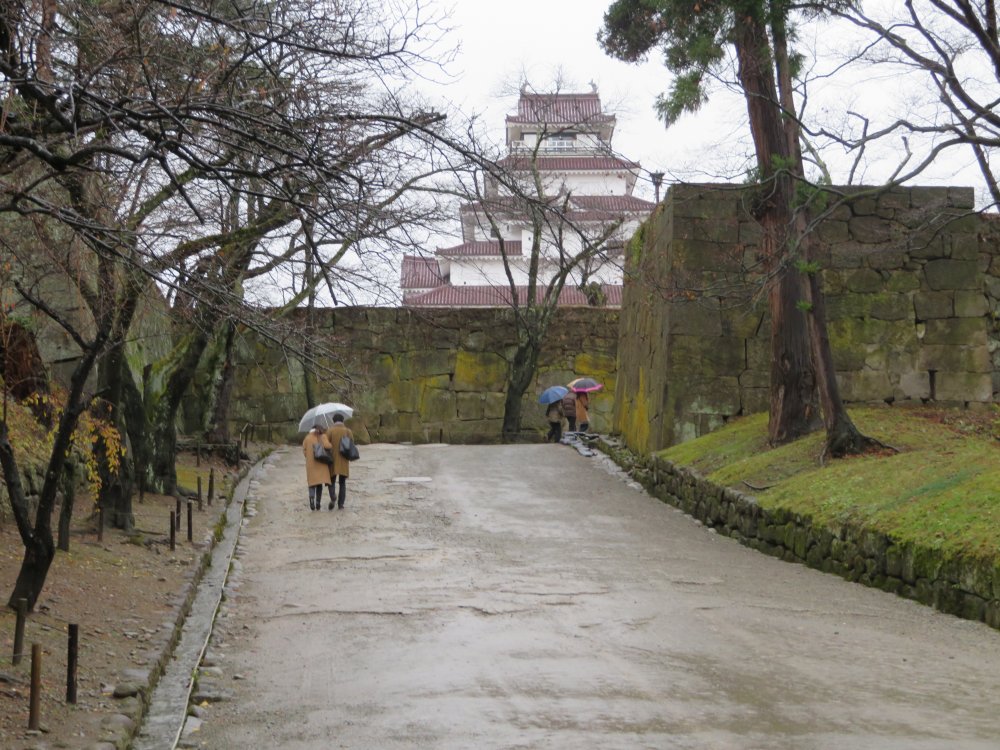
Approaching the castle grounds from the car park.
Remember to purchase a package ticket that admits you to Oyakuen, the keep of Tsuruga Castle and the tea ceremony house if you plan to visit all three as it’s cheaper. Our guide took us into the keep which is a museum up to the top where you can command a good view of the township. We thanked and parted with our guide at the exit from the keep. I understand there are English speaking volunteer guides, but would suggest you book in advance to play safe. We briefly explored the tea ceremony grounds.
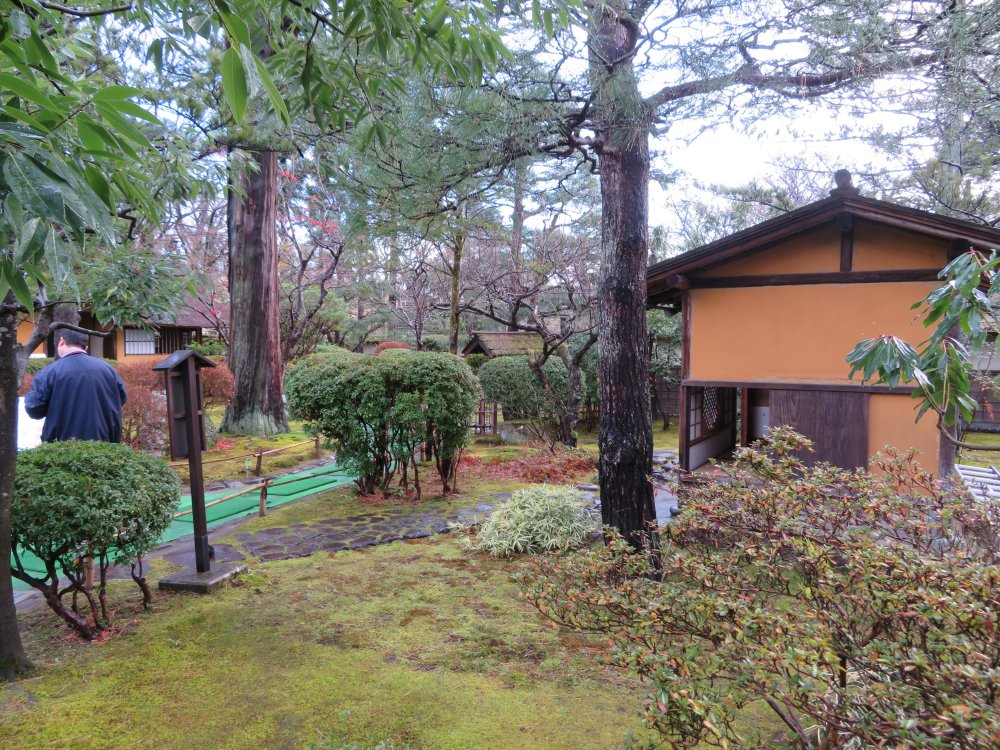
We briefly explored the tea ceremony grounds.
What I had never appreciated before doing some search on Aizu is that at one time there was a significant Christian population under the influence of the Christian feudal lord Ujisato Gamou. Christianity was subsequently banned by the Tokugawa military government but according to the tourism brochures of Aizu City some heritage could be found in the outskirts of the city. We went to one Christian graveyard in the middle of meadows. It was getting dark and we headed to our lodging for the night in Yunokami Onsen in Shimogou town in the south.
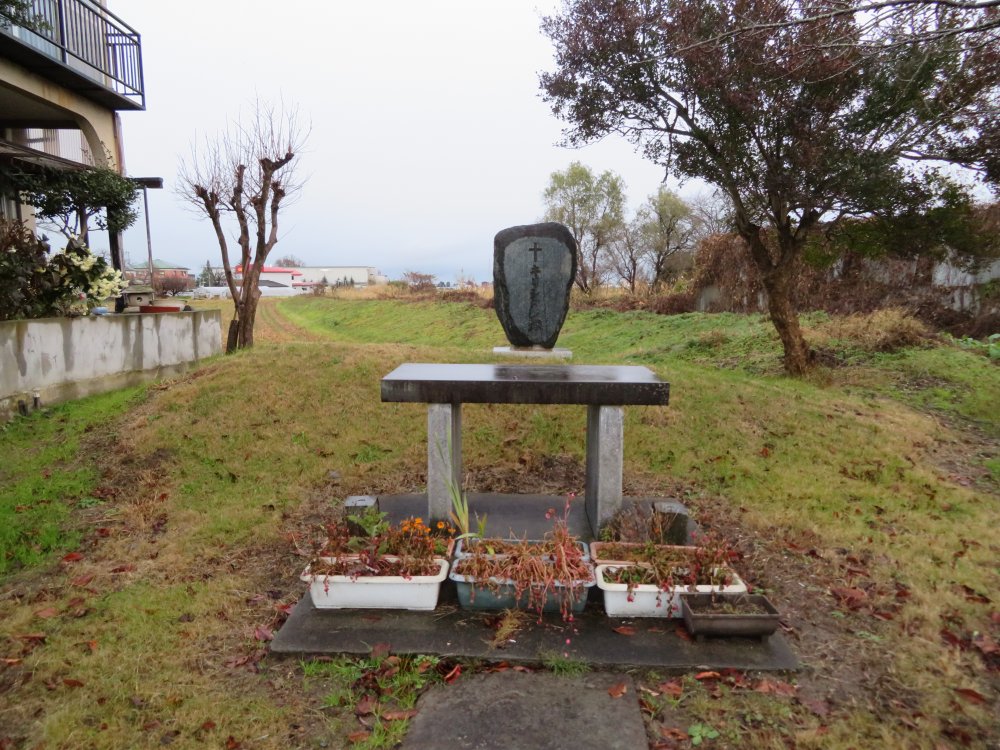
We went to one Christian graveyard in the middle of meadows.
As I spoke earlier I bought a 1.8 liter bottle of special honjouzou Miyaizumi.
Because the rice has been polished to an unusually high sixty per cent
for a honjouzou I found it richer with a pleasant bouquet.
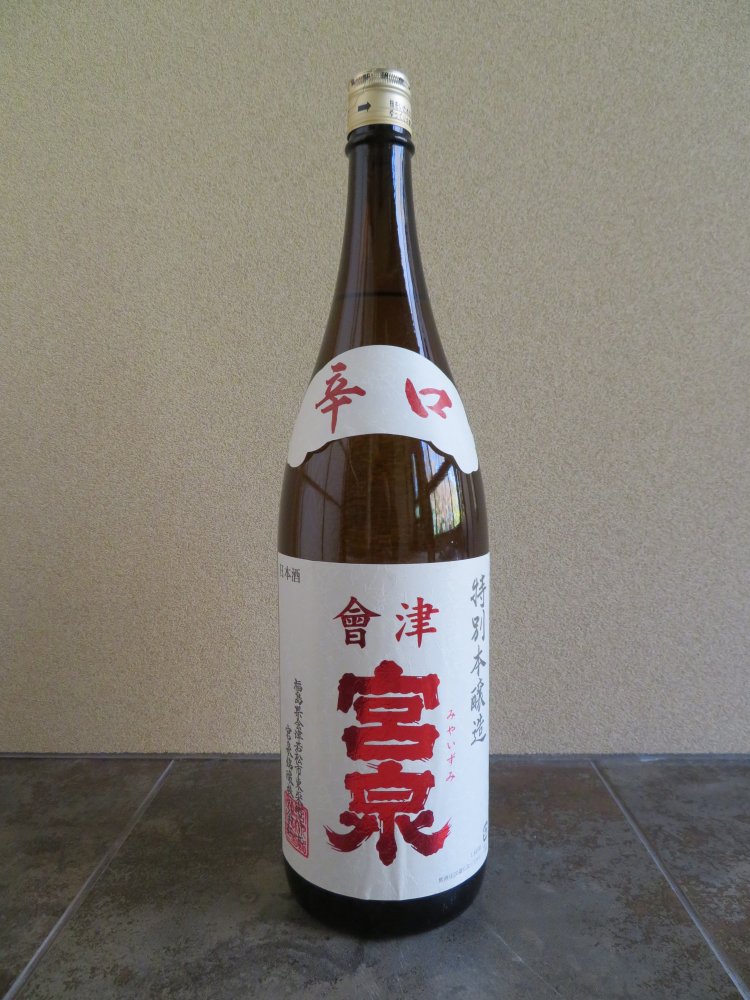
I bought a 1.8 liter bottle of special honjouzou Miyaizumi. Because the rice has been polished to an unusually high sixty per cent for a honjouzou I found it richer with a pleasant bouquet.